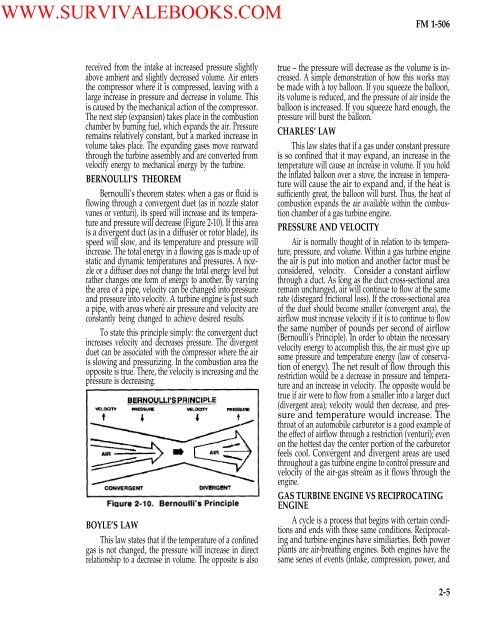FM 1-506 Fundamentals of Aircraft Power Plants ... - Survival Books
FM 1-506 Fundamentals of Aircraft Power Plants ... - Survival Books
FM 1-506 Fundamentals of Aircraft Power Plants ... - Survival Books
You also want an ePaper? Increase the reach of your titles
YUMPU automatically turns print PDFs into web optimized ePapers that Google loves.
WWW.SURVIVALEBOOKS.COM<strong>FM</strong> 1-<strong>506</strong>received from the intake at increased pressure slightlyabove ambient and slightly decreased volume. Air entersthe compressor where it is compressed, leaving with alarge increase in pressure and decrease in volume. Thisis caused by the mechanical action <strong>of</strong> the compressor.The next step (expansion) takes place in the combustionchamber by burning fuel, which expands the air. Pressureremains relatively constant, but a marked increase involume takes place. The expanding gases move rearwardthrough the turbine assembly and are converted fromvelocity energy to mechanical energy by the turbine.BERNOULLI’S THEOREMBernoulli’s theorem states: when a gas or fluid isflowing through a convergent duet (as in nozzle statorvanes or venturi), its speed will increase and its temperatureand pressure will decrease (Figure 2-10). If this areais a divergent duct (as in a diffuser or rotor blade), itsspeed will slow, and its temperature and pressure willincrease. The total energy in a flowing gas is made up <strong>of</strong>static and dynamic temperatures and pressures. A nozzleor a diffuser does not change the total energy level butrather changes one form <strong>of</strong> energy to another. By varyingthe area <strong>of</strong> a pipe, velocity can be changed into pressureand pressure into velocity. A turbine engine is just sucha pipe, with areas where air pressure and velocity areconstantly being changed to achieve desired results.To state this principle simply: the convergent ductincreases velocity and decreases pressure. The divergentduet can be associated with the compressor where the airis slowing and pressurizing. In the combustion area theopposite is true. There, the velocity is increasing and thepressure is decreasing.BOYLE’S LAWThis law states that if the temperature <strong>of</strong> a confinedgas is not changed, the pressure will increase in directrelationship to a decrease in volume. The opposite is alsotrue – the pressure will decrease as the volume is increased.A simple demonstration <strong>of</strong> how this works maybe made with a toy balloon. If you squeeze the balloon,its volume is reduced, and the pressure <strong>of</strong> air inside theballoon is increased. If you squeeze hard enough, thepressure will burst the balloon.CHARLES’ LAWThis law states that if a gas under constant pressureis so confined that it may expand, an increase in thetemperature will cause an increase in volume. If you holdthe inflated balloon over a stove, the increase in temperaturewill cause the air to expand and, if the heat issufficiently great, the balloon will burst. Thus, the heat <strong>of</strong>combustion expands the air available within the combustionchamber <strong>of</strong> a gas turbine engine.PRESSURE AND VELOCITYAir is normally thought <strong>of</strong> in relation to its temperature,pressure, and volume. Within a gas turbine enginethe air is put into motion and another factor must beconsidered, velocity. Consider a constant airflowthrough a duct. As long as the duct cross-sectional arearemain unchanged, air will continue to flow at the samerate (disregard frictional loss). If the cross-sectional area<strong>of</strong> the duet should become smaller (convergent area), theairflow must increase velocity if it is to continue to flowthe same number <strong>of</strong> pounds per second <strong>of</strong> airflow(Bernoulli’s Principle). In order to obtain the necessaryvelocity energy to accomplish this, the air must give upsome pressure and temperature energy (law <strong>of</strong> conservation<strong>of</strong> energy). The net result <strong>of</strong> flow through thisrestriction would be a decrease in pressure and temperatureand an increase in velocity. The opposite would betrue if air were to flow from a smaller into a larger duct(divergent area); velocity would then decrease, and pressureand temperature would increase. Thethroat <strong>of</strong> an automobile carburetor is a good example <strong>of</strong>the effect <strong>of</strong> airflow through a restriction (venturi); evenon the hottest day the center portion <strong>of</strong> the carburetorfeels cool. Convergent and divergent areas are usedthroughout a gas turbine engine to control pressure andvelocity <strong>of</strong> the air-gas stream as it flows through theengine.GAS TURBINE ENGINE VS RECIPROCATINGENGINEA cycle is a process that begins with certain conditionsand ends with those same conditions. Reciprocatingand turbine engines have similiarties. Both powerplants are air-breathing engines. Both engines have thesame series <strong>of</strong> events (intake, compression, power, and2-5
















